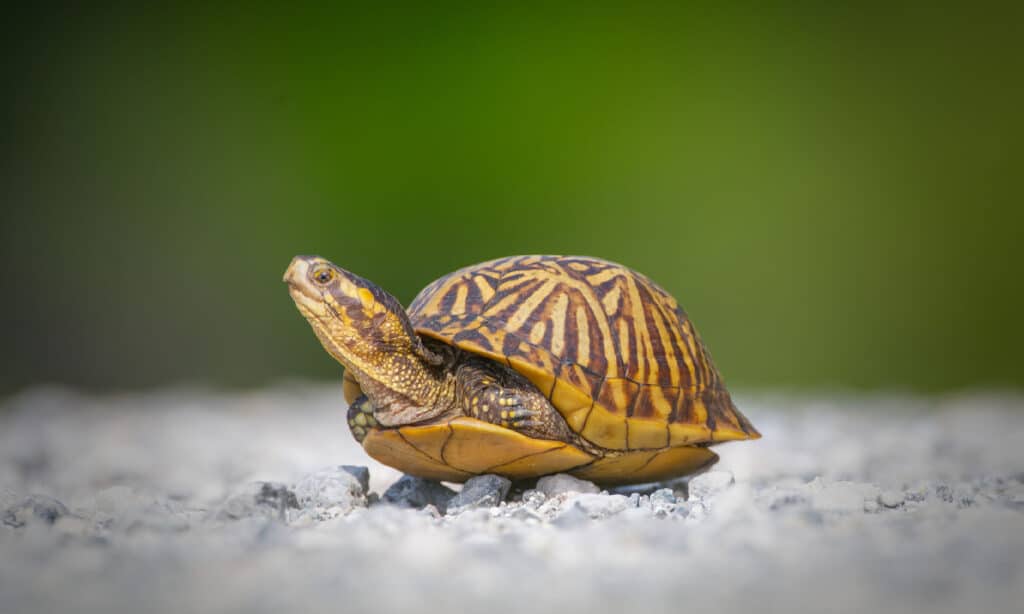Box turtles live on land near water, but can box turtles swim? Let’s discover whether box turtles can survive in water and what precautions to take at home.
Can Box Turtles Swim?

Box turtles swim poorly, and only to move from A to B.
©Ray Hennessy/Shutterstock.com
Box turtles can swim to a degree and they enjoy soaking in water, but their lack of webbed feet and high-domed shells mean they struggle to swim well.
In deep, or moving water, box turtles struggle to stay afloat. Pet box turtles should never live in an aquarium of water but a land-based enclosure with a container of water to soak in.
Can A Box Turtle Drown?
Yes, a box turtle can drown.
These terrestrial animals live on solid ground, but they need water to keep moist. They don’t spend a significant amount of time in the water, but tend to stay close to water sources.
Box turtles may swim in the wild, but only when they need to and usually across shallow water. They don’t swim well like aquatic turtles can, so drowning is a very real possibility.
Do Box Turtles Float or Swim?

Due to non-webbed feet and domed shells, some experts think box turtles don’t swim, but float.
©iStock.com/Dan Rieck
Some turtle experts believe box turtles can’t swim, what they actually do is float and move their legs to try and steer.
A domed shell aids buoyancy, but without aquatic turtles’ flippers, their destination is dependent on the current or environment. However, research shows that Eastern box turtles‘ seasonal movements involve water, which indicates some, if limited, swimming ability.
Is a Box Turtle a Turtle or a Tortoise?

A box turtle is not a tortoise like this sulcata, but part of the
Emydidaefamily of turtles.
©John5199, CC BY 2.0, via Wikimedia Commons – License
Box turtles belong to the scientific Emydidae family, which is also called the terrapin or American pond turtle family. Tortoises sit in the Testudinidae family.
More obvious is a box turtle’s hinged shell, which allows it to totally conceal itself against predators. This is common in tortoises, but a box turtle is a turtle, not a tortoise. They spend much more time near water than a tortoise does, even though their swimming ability is pretty low.
Only the Coahuilan box turtle is truly aquatic, all other box turtle species soak in water to cool off or swim badly to move from A to B.
The most common pets include the eastern box turtle (Terrapene Carolina), the desert box turtle (Terrapene ornata luteola), and the ornate box turtle (Terrapene ornata ornate). These three box turtle species need water to soak in and only swim if absolutely necessary.
Do They Swim Underwater?

A Coahuilan box turtle is the only box turtle that swims well.
©iStock.com/amwu
If the need arises, all box turtles can swim, but they’re not Olympic standard by any stretch of the imagination. They don’t dive or spend time beneath the surface, but they can right themselves if submerged when necessary. They much prefer to stay in the shallows. Only Coahuilan box turtles spend time underwater.
How Long Can a Box Turtle Swim For?
Box turtles don’t have webbed feet, but individual toes, and their domed shells are not streamlined, so swimming is a struggle. Box turtles are survivors with strong instincts, they kick and try to swim until their energy gives out. Given the choice, a box turtle will soak in the shallows, so you won’t spot them enjoying a swim in the deep rivers or ponds.
5 Box Turtle Enclosure Precautions
So, now we know that box turtles can swim (or potentially just float for a while), but only to transport themselves from A to B, let’s discover the precautions an owner must take to keep their box turtle safe.
1. Shallow Water Only

Do not put a box turtle in an aquarium of water, they require a land based enclosure with a water tray.
©iStock.com/slowmotiongli
Box turtles need 24-hour access to water in their enclosure. They need it to cool off and keep their skin, shell, and organs healthy. However, the water must be shallow enough to negate the risk of drowning. Just a few inches of water is enough to ensure a healthy and happy box turtle.
Choose a heavy, strong-lipped bowl that a turtle can fit its entire body into and easily exit. Preferably one that has a deeper end, so if it wants extra depth, it’s there. However, the depth shouldn’t cover its head.
A suitable water tray’s depth will depend on the size of your box turtle.
2. Standing Water Only
Box turtles can’t swim against the current, and moving water is too much for the terrestrial creature to manage, so only offer standing water.
3. Mist the Enclosure
Box turtles require a humid environment. The best way to achieve humidity is misting. Mist the enclosure at least twice a day. The ideal humidity is 65% for box turtles.
4. Change it Frequently
Like most tortoises and turtles, box turtles poop in water. This means daily water changes and a good scrub of the water bowl. Clean drinking water is essential, and it cuts out nasty smells too.
5. Dechlorinated Water
Chlorine in tap water can irritate a box turtle’s eyes and leave white spots on its shell and skin. Instead of tap water, use distilled or bottled mineral water.
Box Turtle: Species Overview
Diet
Omnivorous wild box turtles eat a wide range of food because they’re opportunistic feeders. Food includes berries, fungi, flowers, frogs, insects, fish, and snails. Because they enjoy living near water, bankside aquatic weeds are a favorite.
Offer pet box turtles a range of proteins, fruits, and vegetables. Dark leafy greens are best, plus sparing amounts of apples, pears, bananas, geraniums, dandelions, and hibiscus. Crickets, mealworms, or waxworms give good animal protein.

Habitats
Terrestrial box turtles prefer moist, warm environments such as forests, marshes, meadows, and woodland near a water source. They’re native to the United States and Mexico.
Predators

Vehicles pose danger for box turtles.
©Mark_Kostich/Shutterstock.com
Box turtles are prey for carnivorous animals like birds, raccoons, foxes, and waterside alligators.
When threatened, a box turtle withdraws into its hinged shell, so its limbs are completely covered like it’s in a box – hence the name box turtle.
However, this shell is no match for vehicles. Many box turtles met their end on roads.
Full Size
A box turtle’s full size depends on the species, but most reach adulthood between seven and ten years old. After this period, they stop growing. Pet box turtles can live as long as 100 years, though the average span is 40-50 with good care and shallow water to avoid mishaps.
Box Turtles: Can They Swim or Not?
The jury is out on this question.
Box turtles are not tortoises that avoid water, but they cannot swim well either. Many experts believe box turtles float and use their limbs to try and exit the water. They certainly don’t glide effortlessly through ponds and lakes like aquatic turtles. An exception is the Coahuilan box turtle.
The main takeaway here is to ensure your box turtle doesn’t drown, so do not put one in an aquarium of water under any circumstances. Instead, add water to a moist land-based enclosure. An easy-to-enter and exit water tray that’s several inches deep is sufficient.

Research indicates Eastern box turtles use water to move around depending on the season.
©samray/Shutterstock.com
The photo featured at the top of this post is © iStock.com/Alan Doucet
Thank you for reading! Have some feedback for us? Contact the AZ Animals editorial team.






